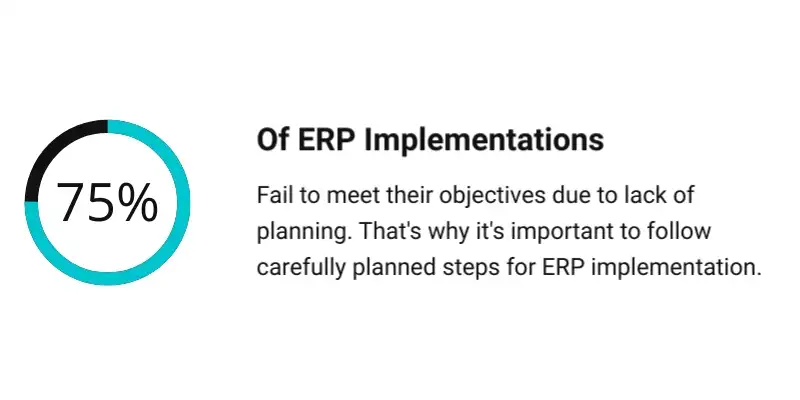Did you know that up to 75% of ERP projects fail to meet their objectives due to a lack of understanding and planning for the different ERP implementation phases? To avoid this, it’s crucial to follow the necessary steps for ERP implementation.
Implementing an ERP system is a complex process that involves careful planning and execution to ensure successful implementation. At NexInfo, we have a team of qualified professionals who have mastered this process. In this article, we will explore the different phases, steps, and strategies involved in the implementation of an ERP system.
The ERP Implementation Roadmap: How to Successfully Implement Your New System
The ERP implementation roadmap consists of three phases: Planning, Design and Build, and Deployment. Each phase is critical to the success of the implementation and requires careful planning and execution.
In the Planning Phase, you need to analyze your organization’s needs and define project objectives. You should also establish a budget and timeline for the implementation.
This will help you to identify potential challenges and risks and develop strategies to mitigate them. For example, if you are upgrading your system, you may need to train your staff on new features and functionality.
In the Design and Build Phase, you will work with a team of experts to create a blueprint of the system that aligns with your organization’s requirements.
This phase involves using the latest development methodologies and tools to design and build the system. You will need to work closely with your team to ensure that the system meets your needs and is scalable for future growth.
| Learn more about ERP implementation on our blog: |
The Deployment Phase is when you finalize the implementation and roll out the system to users. During this phase, you need to ensure that the system is working correctly and that your staff is trained to use the new system. You will also need to develop strategies for addressing any issues that arise during the transition.
Essential ERP Implementation Strategies for Success
If you want your implementation to go off without a hitch, here are some ERP implementation strategies to keep in mind:
Get Your Team Involved: Make sure to involve key stakeholders from your organization in each phase of the ERP system implementation process. This will ensure that you get valuable feedback and insights, which can help to make the project a success.
Keep Everyone in the Loop: Communication is key. Make sure to keep your team and users up-to-date on the project’s status. This will help to build trust and alleviate any concerns or worries about the new system.
Test Everything: It’s crucial to test the system thoroughly before deployment. This will help to identify and fix any potential issues or glitches, which will minimize disruptions to your business operations.
Train Your Staff: Providing training to your staff is essential. It ensures that they’re prepared to use the new system effectively and minimize mistakes.
To guarantee a seamless transition and give your organization the capability to thrive with its new ERP system in the long term, you must adhere to an accurately developed ERP implementation roadmap. Doing so will grant you access to ideal tactics for each stage of the installation process, guaranteeing success!

The 5-Step ERP Implementation Checklist
Here are the 5 steps of a successful ERP implementation project.
1. Evaluate
First, you should thoroughly plan the project and evaluate your current operations. This includes checking:
- How mature your processes are
- How well they fit your organization
- How accessible your information is
- How well your systems support your processes
From there, you can use that information to formulate an implementation plan tailored to your needs.
2. Educate
The point of this step is to conduct a preliminary fit-gap analysis. Then, you can establish a roadmap for process improvements. You should also teach your project team about the best practices for your new ERP software.
3. Architect
The goal of this phase is to clearly define how the new solution will change current operational processes. Once that’s defined, you can establish how you can set up you new system to support future growth.
4.Validate
Next, you should conduct rigorous tests to ensure your new ERP will work well with operations. You should also verify that it will work well with future business operations. Make sure all process tests are successful before rolling it out to your users.
Installing an ERP Takes More Than Buying the Software
5. Operate
Finally, you can start using the ERP. Think of this step as a repeating phase instead of a final end. You should be ready to tweak the model so it can deal with any issues that come up during regular operations.
Simplify Your Business Operations with NexInfo’s Expert ERP Implementation Services
NexInfo offers a tailored approach for businesses seeking to implement an ERP system. Our phased approach includes a thorough assessment of business processes, data migration, user training, and post-implementation support. Our project management strategies ensure a smooth rollout, whether you choose a big-bang approach or a parallel adoption of legacy systems.
NexInfo team of certified professionals works closely with your project team to design a custom ERP system that integrates seamlessly with your existing infrastructure and software. The implementation phase typically takes weeks or months, depending on the scope of your project plan.
By partnering with NexInfo, you can enjoy improved efficiency, productivity, and visibility across your organization. Don’t let the complexity of implementing an ERP system hold you back. Trust in our expertise and make your transition to ERP simple and stress-free! Contact us today to learn more about how we can help you streamline your business operations.








